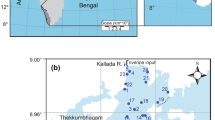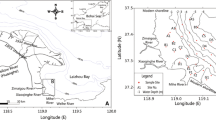Abstract
Due to the large volume of the Heuksan mud belt (HMB), the source of the mud and the depositional processes involved have been controversially discussed over the past two decades. To illuminate the issue, an end-member analysis (EMA) was applied to the grain-size data of 74 surficial samples in order to determine the sediment dispersal pattern on the HMB. In addition, a sedimentary facies analysis was carried out to serve an interpretation of depositional processes. Five grain-size end-members (EMs) were identified. Their dominant modes are 1.4 (EM1), 2.4 (EM2), 3.9 (EM3), 5.6 (EM4), and 7.3 ϕ (ΕΜ5). The EM3 and EM4 are mainly found on the inner shelf, their distribution decreasing from proximal to distal. On the middle shelf, where tidal rhythmites are found, the end-member scores show a mixture of EM4 and EM5, implying that these are good proxies for tidal influence. The distribution of EM4 decreases gradually from proximal to distal, whereas the finest end-member (EM5) increases toward the distal region. It indicates the outcome of progressive size-sorting with distance from the source area. As such, EM4 and EM5 can be interpreted to have been derived from Korean rivers. Previous geochemical and clay mineral studies suggested that sediments were partly supplied from Chinese rivers. The differences between the sedimentological and geochemical results suggest that the sediments may have been redistributed by tidal currents. Consequently, the end-member modeling of grain-size distributions of sediments from the western shelf of Korea has allowed the identification of the main sediment dispersal and depositional mechanisms.








Similar content being viewed by others
References
Alexander CR, DeMaster DJ, Nittrouer CA (1991) Sediment accumulation in a modern epicontinental-shelf setting: the Yellow Sea. Mar Geol 98:51–72
Anthony EJ, Héquette A (2007) The grain-size characterization of coastal sand from the Somme estuary to Belgium: sediment sorting processes and mixing in a tide- and storm-dominated setting. Sediment Geol 202:369–382
Bartholomä A, Flemming BW (2007) Progressive grain-size sorting along an intertidal energy gradient. Sediment Geol 202:464–472
Blott SJ, Pye K (2001) GRADISTAT: a grain size distribution and statistics package for the analysis of unconsolidated sediments. Earth Surf Proc Landforms 26:1237–1248
Cattaneo A, Correggiari A, Langone L, Trincardi F (2003) The late-Holocene Gargano subaqueous delta, Adriatic shelf: sediment pathways and supply fluctuations. Mar Geol 193:61–91
Chang TS, Ha HJ (2015) The Heuksan mud belt on the tide-dominated shelf of Korea: a supply-driven depositional system? Geo-Mar Lett 35:447–460
Chang TS, Ha HJ, Chun SS (2015) Factors controlling mud accumulation in the Heuksan mud belt off southwestern Korea. Geo-Mar Lett 35:461–473
Chang PH, Isobe A (2003) A numerical study on the Changjiang diluted water in the Yellow and East China Seas. J Geophys Res 108:3299
Cho HG, Kim SO, Kwak KY, Choi H, Khim BK (2015) Clay mineral distribution and provenance in the Heuksan mud belt, Yellow Sea. Geo-Mar Lett 35:411–419
Choi BH, Fang G (1993) A review of tidal models for the East China and Yellow Seas. J. Korean Soc. Coast Ocean Eng 5:151–171
Choi JK, Park YJ, Ahn JH, Lim HS, Eom J, Ryu JH (2012) GOCI, the world’s first geostationary ocean color observation satellite, for the monitoring of temporal variability in coastal water turbidity. J Geophys Res 117:C09004
Chough SK, Lee HJ, Chun SS, Shin YS (2004) Deposition processes of late Quaternary sediments in the Yellow Sea: a review. Geosci J 8:211–264
Cummings DI, Arnott RWC, Hart BS (2006) Tidal signatures in a shelf-margin delta. Geology 34:249–252
Dietze E, Hartmann K, Diekmann B, Ijmker J, Lehmkuhl F, Opitz S, Stauch G, Wünnemann B, Borchers A (2012) An end-member algorithm for deciphering modern detrital processes from lake sediments of Lake Donggi Cona, NE Tibetan Plateau, China. Sediment Geol 243:169–180
Flemming BW (1988) Process and pattern of sediment mixing in a microtidal coastal lagoon along the west coast of South Africa. In: de Boer PL, van Gelder A, Nio SD (eds) Tide-influenced sedimentary environments and facies. D Reidel, Dordrecht, pp 275–288
Flemming BW (2007) The influence of grain-size analysis methods and sediment mixing on curve shapes and textural parameters: implications for sediment trend analysis. Sediment Geol 202:425–435
Folk RL, Ward WC (1957) Brazos river bar: a study in the significance of grain size parameters. J Sediment Res 27:3–26
Frenz M, Höppner R, Stuut JBW, Wagner T, Henrich R (2003) Surface sediment bulk geochemistry and grain-size composition related to the oceanic circulation along the South American continental margin in the Southwest Atlantic. In: Wefer G, Mulitza S, Ratmeyer V (eds) The South Atlantic in the Late Quaternary: reconstruction of material budgets and current systems. Springer, Berlin, pp 347–373
Goff JA, Austin JA Jr, Gulick S, Nordfjord S, Christensen B, Sommerfield C, Olson H, Alexander C (2005) Recent and modern marine erosion on the New Jersey outer shelf. Mar Geol 216:275–296
Ha HJ, Chun SS, Chang TS (2013) Distribution pattern, geochemical composition, and provenance of the Huksan Mud Belt sediments in the southeastern Yellow Sea. J Korean Earth Sci Soc 34:289–302 (in Korean with English abstract)
Hanebuth TJJ, Lantzsch H, Nizou J (2015) Mud depocenters on continental shelves-appearance, initiation times, and growth dynamics. Geo-Mar Lett 35:487–503
Hu B, Yang Z, Qiao S, Zhao M, Fan D, Wang H, Bi N, Li J (2014) Holocene shifts in riverine fine-grained sediment supply to the East China Sea Distal Mud in response to climate change. Holocene 24:1253–1268
Hwang JH, Van SP, Choi BJ, Chang YS, Kim YH (2014) The physical processes in the Yellow Sea. Ocean Coast Manag 102:449–457
Jiang H, Wan S, Ma X, Zhong N, Zhao D (2017) End-member modeling of the grain-size record of Sikouzi fine sediments in Ningxia (China) and implications for temperature control of Neogene evolution of East Asian winter monsoon. PLoS One 12:e0186153
Jin JH, Chough SK (1998) Partitioning of transgressive deposits in the southeastern Yellow Sea: a sequence stratigraphic interpretation. Mar Geol 149:79–92
KIGAM (2014) Geological characterization of recent muddy sediment for reservoir potential, and in-situ analysis of shallow gas. Korea Institute of Geoscience and Mineral Resources (KIGAM) Research Report GP2014–005–2014 (3), Daejeon, p 367
Lee HJ (2015) A review on the Holocene evolution of an inner-shelf mud deposit in the southeastern Yellow Sea: the Huksan Mud Belt. Ocean Sci J 50:615–621
Lee HJ, Chu YS (2001) Origin of inner-shelf mud deposit in the southeastern Yellow Sea: Huksan Mud Belt. J Sediment Res 71:144–154
Lee GS, Yoo DG, Bae SH, Min GH, Kim SP, Choi H (2015) Seismic stratigraphy of the Heuksan mud belt in the southeastern Yellow Sea, Korea. Geo-Mar Lett 35:433–446
Lie HJ, Cho CH, Lee S (2009) Tongue-shaped frontal structure and warm water intrusion in the southern Yellow Sea in winter. J Geophys Res 114:C01003
Lie HJ, Cho CH, Lee S (2013) Frontal circulation and westward transversal current at the Yellow Sea entrance in winter. J Geophys Res 118:3851–3870
Lim DI, Choi JY, Jung HS, Rho KC, Ahn KS (2007) Recent sediment accumulation and origin of shelf mud deposits in the Yellow and East China Sea. Prog Oceanogr 73:145–159
Lim DI, Jung HS, Choi JY, Yang S, Ahn KS (2006) Geochemical compositions of river and shelf sediments in the Yellow Sea: grain-size normalization and sediment provenance. Cont Shelf Res 26:15–24
Lim DI, Shin IH, Jung HS (2007) Major elemental compositions of Korean and Chinese river sediments: potential tracers for the discrimination of sediment provenance in the Yellow Sea. J Korean Earth Sci Soc 28:311–323 (Korean with English abstract)
Naimie CE, Blain CA, Lynch DR (2001) Seasonal mean circulation in the Yellow Sea - a model-generated climatology. Cont Shelf Res 21:667–695
Nittrouer CA, Kuehl SA, DeMaster DJ, Kowsmann RO (1986) The deltaic nature of Amazon shelf sedimentation. Geol Soc Am Bull 97:444–458
Ogston AS, Sternberg RW (1999) Sediment-transport events on the northern California continental shelf. Mar Geol 154:69–82
Park YA, Khim BK (1992) Origin and dispersal of recent clay minerals in the Yellow Sea. Mar Geol 29:205–213
Park SC, Lee HH, Han HS, Lee GH, Kim DC, Yoo DG (2000) Evolution of late Quaternary mud deposits and recent sediment budget in the southeastern Yellow Sea. Mar Geol 170:271–288
Park SC, Lee BH, Han HS, Yoo DG, Lee CW (2006) Late Quaternary stratigraphy and development of tidal sand ridges in the eastern Yellow Sea. J Sediment Res 76:1093–1105
Paterson GA, Heslop D (2015) New methods for unmixing sediment grain size data. Geochem Geophys Geosyst 16:4494–4506
Prins MA, Bouwer LM, Beets CJ, Troelstra SR, Weltje GJ, Kruk RW, Kuijpers A, Vroon PZ (2002) Ocean circulation and iceberg discharge in the glacial North Atlantic: inferences from unmixing of sediment size distributions. Geology 30:555–558
Prins MA, Weltje GJ (1999) End-member modelling of siliciclastic grain size distributions: the late Quaternary record of eolian and fluvial sediment supply to the Arabian Sea and its paleoclimatic significance. In: Harbaugh J, Waney L, Rankey G, Slingerland R, Goldstein R, Franseen E (eds) Numerical experiments in stratigraphy: computer simulations, vol 62. SEPM special publication, pp 91–111
Rao W, Mao C, Wang Y, Su J, Balsam W, Ji J (2015) Geochemical constraints on the provenance of surface sediments of radial sand ridges off the Jiangsu coastal zone, East China. Mar Geol 359:35–49
Reineck HE, Singh IB (1980) Depositional sedimentary environments, 2nd edn. Springer, New York
Reineck HE, Wunderlich F (1968) Classification and origin of flaser and lenticular bedding. Sedimentology 11:99–104
Shinn YJ, Chough SK, Kim JW, Woo J (2007) Development of depositional systems in the southeastern Yellow Sea during the postglacial transgression. Mar Geol 239:59–82
Walling DE, Webb BW (1983) Patterns of sediment yield. In: Gregory KJ (ed) Background to Palaeohydrology. Wiley, Chichester, pp 69–95
Walsh JP, Nittrouer CA (2009) Understanding fine-grained river-sediment dispersal on continental margins. Mar Geol 263:34–45
Walsh JP, Nittrouer CA, Palinkas CM, Ogston AS, Sternberg RW, Brunskill GJ (2004) Clinoform mechanics in the Gulf of Papua, New Guinea. Cont Shelf Res 24:2487–2510
Wei JH, Shi XF, Xin CY, Chen ZH (2000) Distribution patterns of clay minerals in the Yellow Sea and their significance. Yellow Sea: epicontinental shelf in Asia. Proceedings of First Korea-China Symposium on Sedimentary Processes and Depositional Environments, Seoul, Korea, pp 179–186
Weltje GJ (1997) End-member modeling of compositional data: numerical-statistical algorithms for solving the explicit mixing problem. J Math Geol 29:503–549
Weltje GJ, Prins MA (2003) Muddled or mixed? Inferring paleoclimate from size distributions of deep-sea clastics. Sediment Geol 162:39–62
Weltje GJ, Prins MA (2007) Genetically meaningful decomposition of grain-size distributions. Sediment Geol 202:409–424
Yanagi T, Inoue K (1994) Tide and tidal current in the Yellow/East China Seas. La Mer 32:153–165
Yang YY, Jung HS, Lim DI, Li CX (2003) A review on the provenance discrimination of sediments in the Yellow Sea. Earth Sci Rev 63:93–120
Yuan D, Zhu J, Li C, Hu D (2008) Cross-shelf circulation in the Yellow and East China Seas indicated by MODIS satellite observations. J Mar Syst 70:131–149
Funding
This work was supported by the National Research Foundation (TS Chang, NRF-2017R1D1A1B03035060). HKH was supported under the framework of international cooperation program managed by the National Research Foundation of Korea (2020K2A9A2A06036472, FY2020).
Author information
Authors and Affiliations
Corresponding authors
Additional information
Publisher’s note
Springer Nature remains neutral with regard to jurisdictional claims in published maps and institutional affiliations.
Rights and permissions
About this article
Cite this article
Ha, H.J., Chang, T.S. & Ha, H.K. Using end-member analysis to determine sediment dispersal and depositional processes on the Heuksan mud belt, southwest Korean shelf. Geo-Mar Lett 41, 7 (2021). https://doi.org/10.1007/s00367-020-00672-6
Received:
Accepted:
Published:
DOI: https://doi.org/10.1007/s00367-020-00672-6




